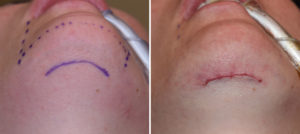Chin reduction is a far more challenging operation in many ways than chin augmentation. Unlike chin augmentation, which rarely has to consider the overlying soft tissue because it stretches it out, this is a major consideration when making the chin smaller. While the chin bone can be reduced in all of its dimensions (height, width and projection), the overlying chin soft tissue pad and the tissues on the underside of the chin do not magically shrink down when its bone support is lessened.
In cases of minor chin bone reshaping an intraoral approach may be effective and not cause adverse soft tissue effects. But the risk of creating a witch’s chin and submental soft tissue redundancies becomes very real as the chin bone reduction becomes greater and more of its soft tissue attachments are released.
The soft tissue issues are not ameliorated by an intraoral sliding genioplasty technique for horizontal chin excess. While cutting and sliding the chin bone back does keep inferior border soft tissues attached and reduces the risk of a witch’s chin deformity, it causes submental fullness as the attached soft tissues get pushed back.

The key to the submental scar is its initial placement on the back edge of the inferior border and in a curved fashion. Its length should never exceed vertical lines drawn down from the mouth corners even during closure if working out dog ears are necessary. The incision should stay within the confines of the mouth width. The other key is when removing soft tissue excess, int is actually worked out of the neck not the soft tissue chin pad. This prevents the resultant scar from ending up on the front edge of the soft tissue chin pad where it could become more visible.
Dr. Barry Eppley
Indianapolis, Indiana


